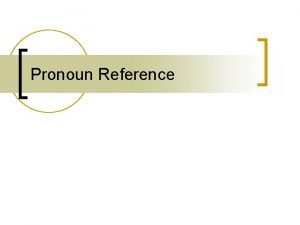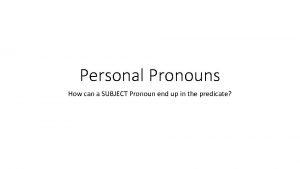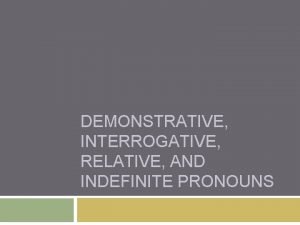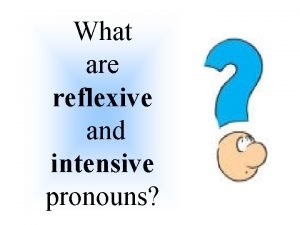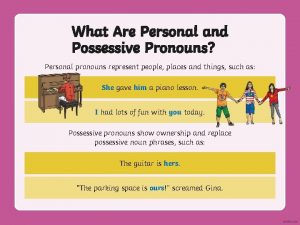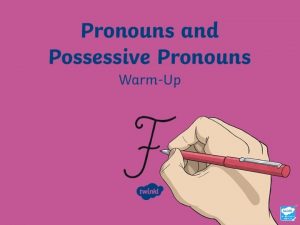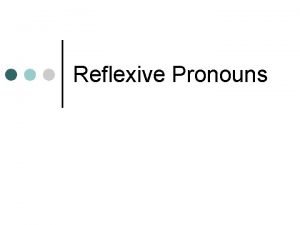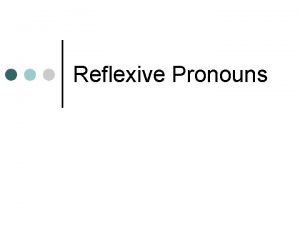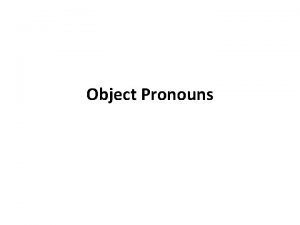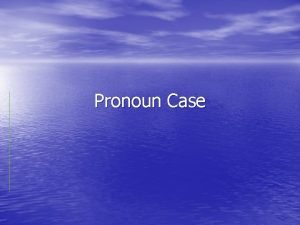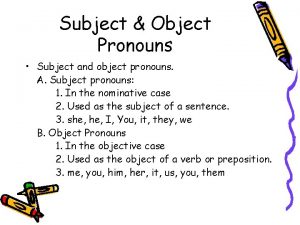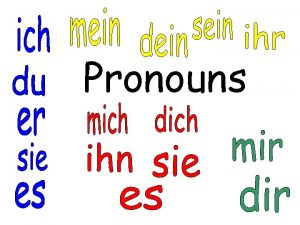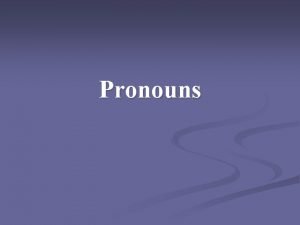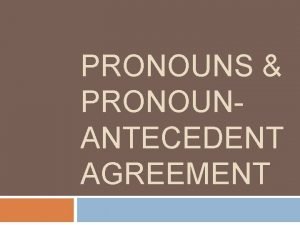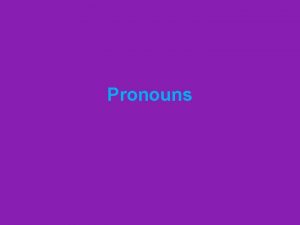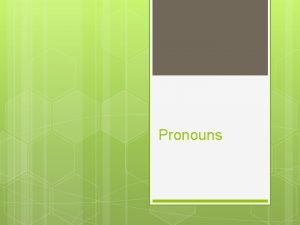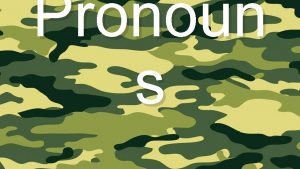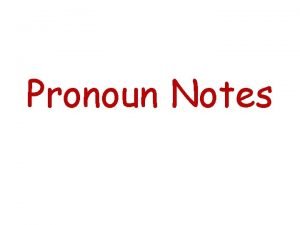PRONOUNS I Pronouns A A pronoun is a

















- Slides: 17

PRONOUNS

I. Pronouns A. A pronoun is a word that is used in the place of one or more nouns or pronouns. B. Examples: 1. When Anne Davis came to the bus stop she was wearing a cast.

I. Pronouns A. A pronoun is a word that is used in the place of one or more nouns or pronouns. B. Examples: 1. When Anne Davis came to the bus stop she was wearing a cast. (she is a pronoun that replaces “Anne Davis) 2. The trees and bushes are dry; they should be watered.

I. Pronouns A. A pronoun is a word that is used in the place of one or more nouns or pronouns. B. Examples: 1. When Anne Davis came to the bus stop she was wearing a cast. (she is a pronoun that replaces “Anne Davis) 2. The trees and bushes are dry; they should be watered. (the word “they” is a pronoun that replaces “trees and bushes”)

I. Pronouns A. A pronoun is a word that is used in the place of one or more nouns or pronouns. B. Examples: 1. When Anne Davis Came to the bus stop she was wearing a cast. (she is a pronoun that replaces “Anne Davis) 2. The trees and bushes are dry; they should be watered. (they is a pronoun that replaces “trees and bushes”) C. The word or word group that a pronoun replaces is called an antecedent.

1. My aunt sold her car. (The pronoun her replaces the antecedent aunt. )

1. My aunt sold her car. (The pronoun her replaces the antecedent aunt. ) D. Sometimes the antecedent is not given because the reader can understand the meaning without it. 1. Call your mother.

1. My aunt sold her car. (The pronoun her replaces the antecedent aunt. ) D. Sometimes the antecedent is not given because the reader can understand the meaning without it. 1. Call your mother. (The antecedent of your is the person to whom the sentences is directed. )

II. Personal Pronouns A. A personal pronoun refers to the one speaking (first person), the one spoken to (second person), or the one spoken about (third person). B. Singular Plural First Person I, me, my, mine we, us, ours Second Person you, your, yours Third Person he, him, his, hers, she, its they, them, theirs

C. Possessive pronouns (my, mine, ours, yours, hers, his, its, their and theirs) are personal pronouns that show ownership or possession.

C. Possessive pronouns (my, mine, ours, yours, hers, his, its, their and theirs) are personal pronouns that show ownership or possession. 1. Nina stored her suitcase under her bed. 2. Is that suitcase yours or mine?

III. Reflexive and Intensive Pronouns A. (See study guide) First Person myself, ourselves Second Person yourself, yourselves Third Person himself, herself, itself, themselves B. Reflexive Pronoun 1. A reflexive pronoun refers to the subject of the sentence and is necessary to the meaning of the sentence. 2. Examples: They chose the new books for themselves. She gave herself the day off from practicing.

C. Intensive Pronouns 1. An intensive pronoun is just there to emphasize the antecedent and is not needed to understand the meaning of the sentence.

C. Intensive Pronouns 1. An intensive pronoun is just there to emphasize the antecedent and is not needed to understand the meaning of the sentence. 2. Examples: The president himself shook her hand. The awards will be given by the principal herself.

IV. Demonstrative Pronouns A. Demonstrative Pronouns this, that, these, those B. A demonstrative pronoun points out a specific person, place, thing, or idea. (think demonstrates) 1. Examples: What is that? These are the right shoes. C. This, that, these, and those can also be adjectives. When they are used to modify a noun or pronoun, they are called demonstrative adjectives.

IV. Demonstrative Pronouns A. Demonstrative Pronouns This, that, these, those B. A demonstrative pronoun points out a specific person, place, thing, or idea. (think demonstrates) 1. Examples: What is that? These are the shoes to wear. C. When they are used as to modify a noun or pronoun, they are called demonstrative adjectives.

V. Indefinite Pronouns A. Singular Plural Singular or Plural anybody, anyone, both, few, all, any, more, anything, each, either, many, several most, none, some everybody, everyone, everything, neither, nobody, nothing, no one, somebody, someone, something B. An indefinite pronoun refers to a person, place, thing, or idea that may or may not be specifically named. 1. Examples: Everyone in the class was invited. None of the boys knew much about camping.
 Pronoun list
Pronoun list Predicate pronouns
Predicate pronouns Interrogative and relative pronouns
Interrogative and relative pronouns Subject pronoun
Subject pronoun Reflexive and intensive pronouns practice
Reflexive and intensive pronouns practice Interrogative possessive pronoun
Interrogative possessive pronoun Possessive personal pronouns
Possessive personal pronouns Reflexive pronouns and reciprocal pronouns
Reflexive pronouns and reciprocal pronouns Personal pronouns and possessive pronouns
Personal pronouns and possessive pronouns Reflexive pronouns definition
Reflexive pronouns definition Reflexive pronouns definition
Reflexive pronouns definition Subject pronouns and object pronouns exercises
Subject pronouns and object pronouns exercises Interrogative demonstrative pronouns
Interrogative demonstrative pronouns Indifinate pronouns
Indifinate pronouns I, you, he, she, it, we, they sentences
I, you, he, she, it, we, they sentences What is a pronoun case
What is a pronoun case Relative clause
Relative clause Subject pronoun
Subject pronoun
